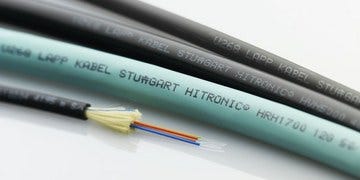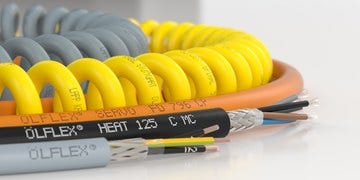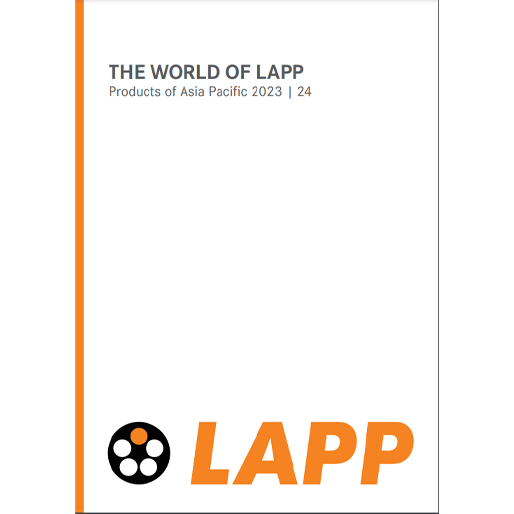Flexible cables and lines for fixed and moving applications
What are flexible cables and wires?
The simplest line is a solid wire with a plastic sheath. It can be bent and will keep this bend - if you don't do it too often, the wire will break. Such simple lines occur in house installations. Once laid, the cable will remain in place for decades, untouched. Such solid wires are not suitable for many other applications where cables have to be flexible and elastic. There the conductors in the cores consist of strands, bundles of fine wires, which, depending on the design, can be bent millions of times without breaking and losing their properties or transmitting electricity or data.
One of the most grueling places to use a cable is on a drag chain. There power, servo and data lines are close together and move back and forth in the work cycle of a machine. Sometimes faster than five meters per second with more than five times the acceleration of gravity. The cables are laid in the drag chain in such a way that they are only bent in one direction. But this is only one of three possible types of movement:
- Bending: The line is bent, sometimes millions of times;
- Torsion: The cable is twisted lengthways. Pure torsional movements can be found in wind turbines in cables that lead from the rotating gondola down into the tower. But they are rare, in most applications lines are both bent and twisted;
- Rewinding and unwinding: This applies to cables, for example in event technology or in live TV, which are unrolled from drums and then rolled up again and stored after the event.
Special robot cables differ in many ways from other robust cables for moving applications. The most important difference: Robot cables can withstand both bending and torsion over their entire service life; they are fundamentally designed differently during development than, for example, a drag chain cable. Three parameters are important for a robot cable:
- Stranded conductor class: Robot cables that are exposed to torsional loads usually have "fine-stranded" class 5 strands. Highly flexible cables such as ÖLFLEX® FD or ÖLFLEX® CHAIN , which are exposed to pure bending loads, for example in energy chains or linearly moving axes of portal robots, even contain "finely stranded" Class 6 strands, however, even the highest class 6 stranded conductors are not sufficient for the highest demands. At LAPP, for example, for cables that have to be highly flexible, we use strands outside of the standard, in which the individual wires with a diameter of up to 0.05 millimeters are considerably thinner than the thinnest stranded wires within the standard.
- Torsion angle: This angle is given in degrees per meter of cable length. A typical value is 360 ° / m, so a line can be twisted around its axis once per meter length without being damaged. This applies to lines without shielding; with shielding, the value is typically 180 ° or half a turn per meter.
- Bending radius: This should be between four and 7.5 times the outer diameter and thus in some cases significantly less than for cables that are only designed for occasional movement. This allows the line to be routed in tight radii and tightly packed in hose packages.
In addition to the stranded conductor class, there are other aspects that distinguish a flexible cable from a less flexible one. One is stranding. To understand what this means, here is a comparative example that everyone knows: a braid of hair. The tighter you braid it, the thicker it becomes, thicker and thinner areas alternate. If you simply gather the same number of hairs into a parallel bundle, it will be noticeably thinner. The thickness increases as you twist the bundle of hair. Something similar happens with the copper strands during stranding. The fine metal wires are twisted because this improves flexibility - if all the strands and all the wires were running in parallel, the copper wires on the outside would be stretched and the copper wires on the inside would be compressed with every bend in the cable. This would make the line very rigid. The thickness and flexibility can be controlled by the length of the lay: the distance for one turn of the twist. If it is longer and therefore the twist is less, the cable will be thinner.
Lines that are moved a lot contain a sliding support: It helps the components inside to move against each other with as little friction as possible. They also serve as a filler that keeps the pipe round. This is important when the cable runs through a screw connection or into a connector. If the jacket is not really round, there will be problems with the tightness. Sliding support can be stranded fine plastic fibers that nestle in the spaces between the cores. Thicker cores are often wrapped with a fleece banding made of polytetrafluoroethylene, which makes it easier to slide against each other, especially in the case of torsion.
Whether a cable can withstand such movements for a long time also depends on the jacket material. The material experts have the challenge that besides mobility they usually have to reconcile other properties such as fire behavior or resistance to oil, chemicals and cleaning agents. When it comes to jacket materials, PVC continues to dominate the market, while other materials have established themselves such as thermoplastic elastomers (TPE) or polyurethane, which is the first choice for highly dynamic applications, such as the ÖLFLEX® Servo FD 796 CP . Polypropylene, in particular, has proven itself in moving applications for the core insulator. It has very good electrical insulation properties with high strength and low density.
For very high data rates over long distances, fiber optic cables are the first choice. They consist of plastic fibers (POF) for shorter distances of up to 70 meters, PCF fibers (plastic-coated glass fibers) for distances of up to 100 meters and glass fibers for even greater distances and for applications that require the highest data rates. In principle, all types of fiber are suitable for moving applications, provided the recommended bending radii are adhered to. Then you don't have to worry that a glass fiber could splinter. For the highest transmission performance, however, fiber optic cables should not be less than a bending radius of 15 times the diameter. It doesn't break below that, but the attenuation increases, which means that light is lost in the tight curve and the signal quality suffers. How well a fiber optic cable can withstand movements depends largely on the materials that cover the fiber. Often these are aramids, i.e. textile fibers that give bulletproof vests or fiber-reinforced plastics their special properties. If the cable is stretched, the textile sleeve absorbs the tensile force and prevents the fiber optic cable from being stretched with it.
Where are flexible cables used?
Except for fixed installation, for example in house installation, almost everywhere. In industry in all applications where something moves: On moving machine parts or at processing stations on production lines, in drag chains, on robots, in wind turbines and oil drilling platforms, in vehicles and engines, on cranes and commercial vehicles, also in applications where vibrations occur.
Which flexible cables does LAPP offer?
Almost all cables from the ÖLFLEX® brand and all data cables from the UNITRONIC®, ETHERLINE® and HITRONIC® brands are flexible. There are differences in the bending radii, which must be adhered to. Some cables only allow occasional bending, while others can be bent millions of times. Some cables are specially optimized for torsion. Unfortunately, there is no one cable that covers all applications, but the LAPP application experts find a solution for all possible and impossible purposes. LAPP also offers suitable accessories for connecting flexible cables and protecting them in cable ducts and conduits. The transition on the connector housing is particularly critical in highly dynamic applications, including those with torsion. The housing must hold the cable securely
A good example of how different lines can be optimized are fiber optic cables from LAPP. HITRONIC® TORSION was specially designed for applications with high torsion such as in wind power plants. It has up to twelve glass fibers for single and multimode transmission, a strain relief made of aramid fibers and a halogen-free and flame-retardant sheath made of polyurethane. HITRONIC® HDM has a similar structure, but is particularly suitable for winding and unwinding on cable drums. And HITRONIC® HRM FD is suitable for installation in cable carriers where flexibility is important, but not torsion.
The tests at LAPP in Stuttgart show that LAPP does not make any false promises. Cables for wind turbines are tested for torsion in a twelve-meter-high old elevator shaft - this is unique in the world. Other manufacturers test shorter pieces of cable that they twist at smaller angles and extrapolate this to longer cable lengths. The decisive factor, however, is not what is on the paper, but what comes out under real conditions.






